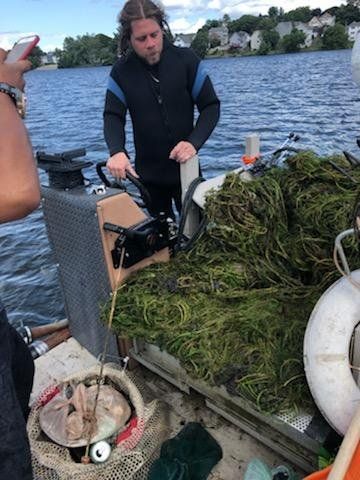Alum (aluminum sulfate) is a nontoxic material commonly used in water treatment plants to clarify drinking water. In lakes, a low dose alum treatment is used to strip the water column of phosphorus. At higher doses, it is often used to inactivate phosphorus in the bottom sediments. This is accomplished by applying an aluminum salt to the lake which reacts with the water to form an insoluble aluminum hydroxide solid (floc). This floc falls through the water column removing phosphorus and then settles to the bottom forming a "blanket".
Phosphorus and nutrients provide food for the algae. Thus excessive phosphorus and nutrient loads can be problematic as they are the main contributing factor in recurring algal blooms.
The practice of using Alum in surface waters has been around for 50+ years and has been utilized successfully on numerous projects in Massachusetts and around the country to lower phosphorus levels and reduce the frequency and severity of nuisance algae blooms.
Beginning in 2015, the ILWA began the season by applying a low dose alum treatment to Indian Lake to ensure that everything possible was being done to be pro-active after the cyanobacteria bloom we experienced in 2014. It has since served as a very successful way to manage nutrients short term with the Lakes and Ponds Program continuing this application at the beginning of each season since that time. .
Ararat Brook (which enters near the intersection of Holden Street and Shore Drive) has long been noted as the largest source of nutrients entering Indian Lake from the watershed. The city of Worcester has made significant improvements to storm water controls throughout the watershed over many years. However, the brook remains problematic. Studies continue to be done to identify nutrient sources within the watershed with particular focus on Ararat Brook yet there has yet to be any particular issues that can be tied to the exact cause.
In 2019, a proposal was brought forward to evaluate an Alum Dosing Station for the Ararat Brook inlet. In Wellesley, MA, this device has been pivotal to reducing nutrients and problematic algae blooms at Morses Pond, which is very similar in size and characteristics to Indian Lake. At Morses Pond, lake clarity has increased from approximately 5 feet to 16 feet throughout the summer. It has reduced the need for algaecides and reduced the cost of overall lake management.
We are very grateful to District 1 City Councilor Sean Rose for taking the time to learn how valuable this tool will be for Indian Lake and quickly supporting the effort. Once installed, the station will automatically apply the alum as needed, seamlessly reducing the nutrients before they reach the water body. The Alum Dosing station will be a state-of-the-art addition to Indian Lake. Installation is expected in 2022.
A special thanks to Bancroft School and the Unitarian Universalist Church which were instrumental in providing land for the equipment and access for this project.
Evaluating and moving forward new ideas in lake management is a huge win for the City of Worcester!






